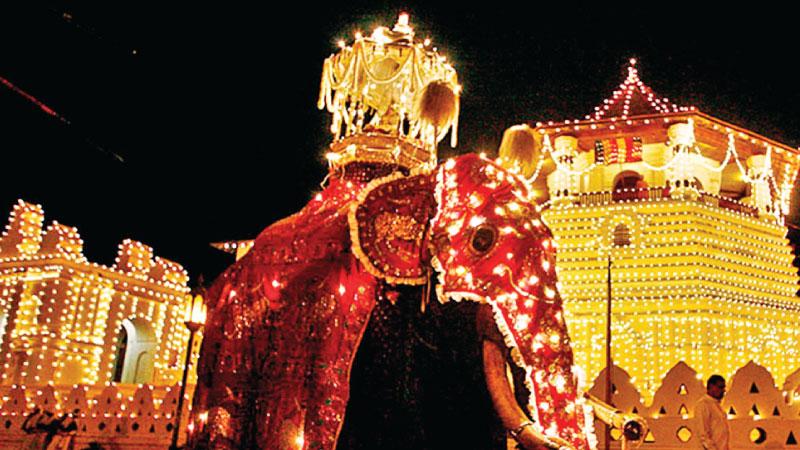
Elephants have been associated with our nation since the time of our magnificent kings. The elephants contributed immensely to help build the amazing structures that still stand to this day. These gentle giants were also integrated into cultural and religious pageants. Some years ago whilst driving past the Bellanwilla Temple, I gazed upon a majestic elephant. I realised that it was the tusker venerated by thousands of Buddhists- Nedungamuwe Raja. He towered above the other elephants present. I was mesmerised by his regal appeal and calm mannerism.
During the past few weeks I tried to contact his owner Dr. Harsha Dharmavijaya, and finally got an appointment to visit him. Nedungamuwe is a rather quiet village, where the tusker resides. Dr. Dharmavijaya is an ayurveda physician, just like his late father who was a famous physician. He explained,
“This tusker has been in the care of our family since 1978. He was born in India in 1954 and belonged to a rich Maharaja.
The stately Maharaja had become seriously ill and a native physician monk from Ceylon traveled there to cure him. Once he recovered the grateful maharaja rewarded the monk of Nilammahara with two baby elephants.
After a few years the monk could not maintain the elephants and Raja was sold to a timber mill in Horana- where he had to work lifting logs. My father had heard of him and we went to see the tusker. My father purchased him and he has been with us ever since. Since the time of my great grandfather we have been taking care of elephants”.
Nedungamuwe Raja belongs to a clan (species) of Asian elephant known locally as Sadhantha Kula and displays the characteristic ‘hathpolaya’– seven features that define this unique elephant’s caste. Even as a young elephant he was ten and a half feet tall, a giant in comparison to the others. His long tusks enriched his majestic appeal. For decades he has been under the loving care of his chief mahout Wilson Koddithuwakku, an amiable man of few words. Yet he understands the body language of the elephant, and wields gentle control over the powerful tusker.
Dr. Dharmavijaya added “As you can see Raja is a big tusker and has a special diet. We feed him with coconut palms, jackfruit palms, Kitul palms and an assortment of fruits - pineapple, mango and bananas. He requires 300 kilograms a day.
He also consumes 400 litres of water from our well. He is taken for a bath to the river by Mahout Wilson- the elephant likes to walk to and from the river. Raja never liked travelling in a lorry. As you all know he walks almost 85 kilometres to Kandy to partake in the Esala Perehara.
It takes him seven days, but he walks patiently. Each day he will stop at a temple on the way, where he is given a bath. People line the streets to greet him and some offer him fruit”.
In 2005 the tusker was nominated to be the main bearer of the sacred karanduwa- carrying the relics of Buddha. The elephant adapted to this role with ease. He is caparisoned in a special costume that takes 180 knots to secure.
Many have said that once the karanduwa is kept on his back, the tusker being aware of his noble task resonates with a great aura that enriches the entire pageant.
As the colourful procession moves along Kandy Lake, Raja is the center of attraction. Hundreds of tourists come to see him in his moment of acclaimed splendour. Reminiscing about the training Dr. Dharmavijaya said “We initially kept a soft mattress on his back.
He had to get accustomed to the straps. Later we placed a chair- to teach him balance as he walked. Months later he would be ready to carry the sacred casket. We monitor his health daily- as elephants can get swollen feet, joint pain, worms in the digestive tract and even arthritis. He is in good health”. The mighty tusker was aware of our presence, but made no acknowledgement. After all he is the king of elephants. Nedungamuwe Raja has performed great services to Sri Lanka.
